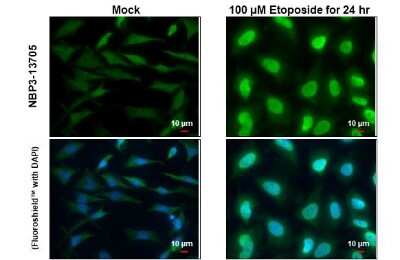ATM [p Ser1981] Antibody (HL1062) - Azide and BSA Free
Novus Biologicals, part of Bio-Techne | Catalog # NBP3-13705
Recombinant Monoclonal Antibody

Key Product Details
Validated by
Biological Validation
Species Reactivity
Human
Applications
Immunocytochemistry/ Immunofluorescence, Immunohistochemistry, Immunohistochemistry-Paraffin, Western Blot
Label
Unconjugated
Antibody Source
Recombinant Monoclonal Rabbit IgG Clone # HL1062
Format
Azide and BSA Free
Concentration
Concentrations vary lot to lot. See vial label for concentration. If unlisted please contact technical services.
Product Specifications
Immunogen
Carrier-protein conjugated synthetic peptide surrounding phospho Ser1981 of human ATM. The exact sequence is proprietary.
Modification
p Ser 1981
Clonality
Monoclonal
Host
Rabbit
Isotype
IgG
Description
Centrifuge briefly prior to opening.
Scientific Data Images for ATM [p Ser1981] Antibody (HL1062) - Azide and BSA Free
Western Blot: ATM [p Ser1981] Antibody (HL1062) [NBP3-13705] - Untreated (-) and treated (+) 293T whole cell extracts (60 ug) were separated by 5% SDS-PAGE, and the membrane was blotted with ATM (phospho Ser1981) antibody [HL1062] (NBP3-13705) diluted at 1:1000. The HRP-conjugated anti-rabbit IgG antibody (NBP2-19301) was used to detect the primary antibody.
Immunocytochemistry/Immunofluorescence: ATM [p Ser1981] Antibody (HL1062) [NBP3-13705] - ATM (phospho Ser1981) antibody [HL1062] detects ATM (phospho Ser1981) protein at nucleus by immunofluorescent analysis. Sample: Mock and treated HeLa cells were fixed in 4% paraformaldehyde at RT for 15 min. Green: ATM (phospho Ser1981) stained by ATM (phospho Ser1981) antibody [HL1062] (NBP3-13705) diluted at 1:500. Blue: Fluoroshield with DAPI.
Immunohistochemistry-Paraffin: ATM [p Ser1981] Antibody (HL1062) [NBP3-13705] - ATM (phospho Ser1981) antibody [HL1062] detects ATM (phospho Ser1981) protein at nucleus by immunohistochemical analysis. Sample: Paraffin-embedded human cervical carcinoma. ATM (phospho Ser1981) stained by ATM (phospho Ser1981) antibody [HL1062] (NBP3-13705) diluted at 1:100. Antigen Retrieval: Citrate buffer, pH 6.0, 15 min
Applications for ATM [p Ser1981] Antibody (HL1062) - Azide and BSA Free
Application
Recommended Usage
Immunocytochemistry/ Immunofluorescence
Optimal dilutions of this antibody should be experimentally determined.
Immunohistochemistry
Optimal dilutions of this antibody should be experimentally determined.
Immunohistochemistry-Paraffin
Optimal dilutions of this antibody should be experimentally determined.
Western Blot
Optimal dilutions of this antibody should be experimentally determined.
Formulation, Preparation, and Storage
Purification
Protein A purified
Formulation
PBS
Format
Azide and BSA Free
Preservative
No Preservative
Concentration
Concentrations vary lot to lot. See vial label for concentration. If unlisted please contact technical services.
Shipping
The product is shipped with polar packs. Upon receipt, store it immediately at the temperature recommended below.
Stability & Storage
Store at 4C short term. Aliquot and store at -20C long term. Avoid freeze-thaw cycles.
Background: ATM
The theoretical molecular weight of ATM is 350 kDa and it has 3 main domains: a FAT (focal adhesion targeting) domain (aa 1960-2566), a PI-3/PI-4 kinase catalytic domain (aa 2712-2962), and a C-terminal FAT domain (aa 3024-3056). ATM exists as a dimer or tetramer in its inactive state. Upon sensing DNA damage, the MRE11-RAD50-NBS1 (MRN) complex recruits ATM. The intricate process of ATM activation involves acetylation by KAT5/TIP60, autophosphorylation at Ser-1981, and dissociation into catalytically active monomers (5). Following activation, ATM phosphorylates multiple substrates such as p53/TP53 and Chk2 involved in DNA repair, checkpoint signaling, and the apoptosis pathway.
/>References
/>1. Paull TT. (2015) Mechanisms of ATM Activation. Annu Rev Biochem. 84:711-38. PMID: 25580527
2. Chaudhary MW and Al-Baradie RS. (2014) Ataxia-telangiectasia: future prospects. Appl Clin Genet. 7:159-167. PMID: 25258552
3. Stagni V, Cirotti C, and Barila D. (2018) Ataxia-Telangiectasia Mutated Kinase in the Control of Oxidative Stress, Mitochondria, and Autophagy in Cancer: A Maestro With a Large Orchestra. Front Oncol. 8:73. PMID: 29616191
4. Gumy-Pause F, Wacker P, and Sappino AP. (2004) ATM gene and lymphoid malignancies. Leukemia. 18(2):238-42. PMID: 14628072
5. Adamowicz M. (2018) Breaking up with ATM. J Immunol Sci. 2(1):26-31. PMID: 29652413
Long Name
Ataxia Telangiectasia-mutated
Alternate Names
TEL1, TELO1, TPLL
Gene Symbol
ATM
Additional ATM Products
Product Documents for ATM [p Ser1981] Antibody (HL1062) - Azide and BSA Free
Product Specific Notices for ATM [p Ser1981] Antibody (HL1062) - Azide and BSA Free
This product is for research use only and is not approved for use in humans or in clinical diagnosis. Primary Antibodies are guaranteed for 1 year from date of receipt.
